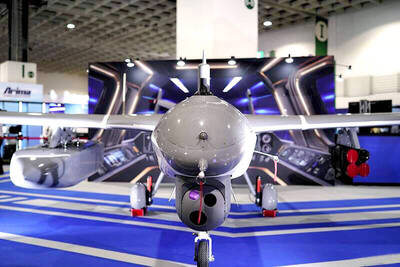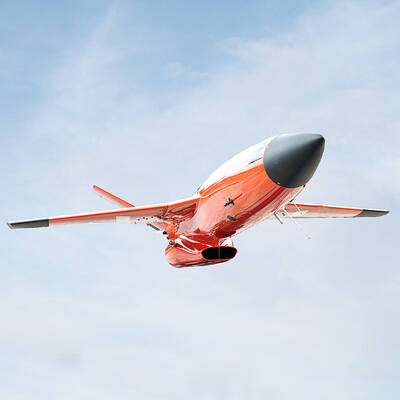US officials said they have little fear that China would attack US House of Representatives Speaker Nancy Pelosi’s plane if she flies to Taiwan.
However, Pelosi would be entering one of the world’s hottest spots, where a mishap, misstep or misunderstanding could endanger her safety, so the Pentagon is developing plans for any contingency.
The officials said that if Pelosi travels to Taiwan — still an uncertainty — the military would increase its movement of forces and assets in the Indo-Pacific region.

Photo: AP
They declined to provide details, but said that fighter jets, ships, surveillance assets and other military systems would likely be used to provide overlapping rings of protection for her flight to Taiwan and any time on the ground there.
Any foreign travel by a senior US leader requires additional security, but officials this week said that a visit to Taiwan by Pelosi — she would be the highest-ranking US elected official to visit Taiwan since 1997 — would go beyond the usual safety precautions for trips to less risky destinations.
Asked about planned military steps to protect Pelosi in the event of a visit, US Joint Chiefs of Staff Chairman General Mark Milley yesterday said that discussion of any specific travel is premature, but added: “If there’s a decision made that Speaker Pelosi or anyone else is going to travel and they asked for military support, we will do what is necessary to ensure a safe conduct of their visit. And I’ll just leave it at that.”
The trip is being considered at a time when China has escalated what the US and its allies in the Pacific describe as risky one-on-one confrontations with other militaries to assert its sweeping territorial claims. The incidents have included dangerously close flybys that force other pilots to swerve to avoid collisions, or harassment or obstruction of air and ship crews, including with blinding lasers or water cannons.
Dozens of such maneuvers have occurred this year alone, US Assistant Secretary of Defense Ely Ratner said on Tuesday at a South China Sea forum by the Center for Strategic and International Studies.
The US officials, who spoke on the condition of anonymity, described the need to create buffer zones around the speaker and her plane. The US already has substantial forces spread across the region, so any increased security could largely be handled by assets already in place.
The military would also have to be prepared for any incident — even an accident either in the air or on the ground. They said the US would need to have rescue capabilities nearby and suggested that could include helicopters on ships already in the area.
Pelosi has not publicly confirmed any new plans for a trip to Taiwan. She was coming in April, but she postponed the trip after testing positive for COVID-19.
US officials have said the administration doubts that China would take direct action against Pelosi herself or try to sabotage the visit.
However, they do not rule out that China could escalate provocative overflights of military aircraft in or near Taiwanese airspace and naval patrols in the Taiwan Strait should the trip take place.
Moreover, they do not preclude Chinese actions elsewhere in the region as a show of strength.

‘WIN-WIN’: The Philippines, and central and eastern European countries are important potential drone cooperation partners, Minister of Foreign Affairs Lin Chia-lung said Minister of Foreign Affairs Lin Chia-lung (林佳龍) in an interview published yesterday confirmed that there are joint ventures between Taiwan and Poland in the drone industry. Lin made the remark in an exclusive interview with the Chinese-language Liberty Times (the Taipei Times’ sister paper). The government-backed Taiwan Excellence Drone International Business Opportunities Alliance and the Polish Chamber of Unmanned Systems on Wednesday last week signed a memorandum of understanding in Poland to develop a “non-China” supply chain for drones and work together on key technologies. Asked if Taiwan prioritized Poland among central and eastern European countries in drone collaboration, Lin

The Chien Feng IV (勁蜂, Mighty Hornet) loitering munition is on track to enter flight tests next month in connection with potential adoption by Taiwanese and US armed forces, a government source said yesterday. The kamikaze drone, which boasts a range of 1,000km, debuted at the Taipei Aerospace and Defense Technology Exhibition in September, the official said on condition of anonymity. The Chungshan Institute of Science and Technology and US-based Kratos Defense jointly developed the platform by leveraging the engine and airframe of the latter’s MQM-178 Firejet target drone, they said. The uncrewed aerial vehicle is designed to utilize an artificial intelligence computer

Renewed border fighting between Thailand and Cambodia showed no signs of abating yesterday, leaving hundreds of thousands of displaced people in both countries living in strained conditions as more flooded into temporary shelters. Reporters on the Thai side of the border heard sounds of outgoing, indirect fire yesterday. About 400,000 people have been evacuated from affected areas in Thailand and about 700 schools closed while fighting was ongoing in four border provinces, said Thai Rear Admiral Surasant Kongsiri, a spokesman for the military. Cambodia evacuated more than 127,000 villagers and closed hundreds of schools, the Thai Ministry of Defense said. Thailand’s military announced that

CABINET APPROVAL: People seeking assisted reproduction must be assessed to determine whether they would be adequate parents, the planned changes say Proposed amendments to the Assisted Reproduction Act (人工生殖法) advanced yesterday by the Executive Yuan would grant married lesbian couples and single women access to legal assisted reproductive services. The proposed revisions are “based on the fundamental principle of respecting women’s reproductive autonomy,” Cabinet spokesperson Michelle Lee (李慧芝) quoted Vice Premier Cheng Li-chiun (鄭麗君), who presided over a Cabinet meeting earlier yesterday, as saying at the briefing. The draft amendment would be submitted to the legislature for review. The Ministry of Health and Welfare, which proposed the amendments, said that experts on children’s rights, gender equality, law and medicine attended cross-disciplinary meetings, adding that